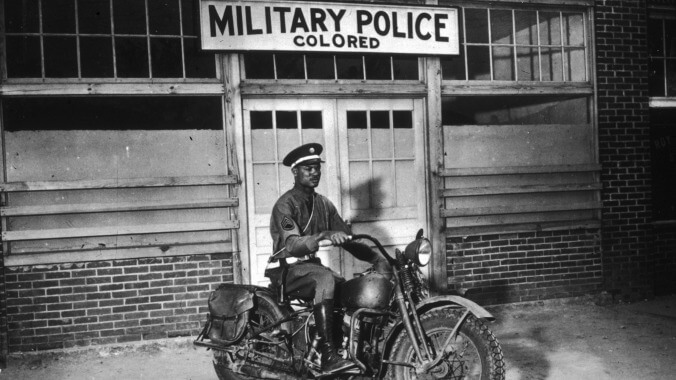A uniformed African American police officer in Columbus, Georgia. Photo: Hulton Archive/Getty Images
This week’s entry: Battle of Bamber Bridge
What it’s about: An unfortunate incident in which American troops stationed in the Lancashire village of Bamber Bridge during World War II fired not on the Germans, but on their fellow American soldiers. Racial tensions boiled over in a logistics unit of the still-segregated Air Force, escalating into a gun battle that resulted in one death and 32 court martials. As with other incidents of racial violence against Black Americans that are only now becoming more widely known, like the Tulsa Massacre of 1921, the Battle of Bamber Bridge was largely censured in the media at the time.
Biggest controversy: The U.S. armed forces were segregated until several years after the war, but most Black units were still led by white officers. Worse, the military had a habit of putting their least competent officers in charge of these units, so leadership and morale was poor. In June of 1943, there was a race riot in Detroit, in which approximately 600 people were injured and 34 were killed, most of them Black. With that news still fresh, tensions ran high among the segregated units of the 1511th Quartermaster Truck Regiment.
Strangest fact: The whole incident started over a jacket. A military police (MP) unit was also stationed in the town, and two white MPs entered a local pub and spotted Private Eugene Nunn, who was African American, wearing a field jacket rather than his full uniform. The MPs attempted to arrest Nunn for this minor offense, despite outcry from the locals in the pub. Nunn’s staff sergeant defused the situation, but someone threw a beer at the MPs’ jeep as they were driving away, and they returned with reinforcements.
The larger group of MPs intercepted the soldiers on their way back to base from the pub. A fight broke out, shots were fired, and Private William Crossland was shot in the back, killing him. The unit’s acting colonel and a lieutenant, who was the unit’s only Black officer, were able to reassure their enlisted men that the MPs would be brought to justice in the morning. Except at midnight, the MPs returned, in still greater numbers. One of their jeeps was turned into an improvised armored vehicle complete with machine gun. The soldiers armed themselves and warned the townspeople to stay inside. The resulting firefight lasted four hours and resulted in seven wounded.
Thing we were happiest to learn: The people of Bamber Bridge had no time for American-style racism. The locals backing up Private Nunn wasn’t the first time Black soldiers had gotten support in the pubs. Their white commanding officers had demanded segregated pubs, and in response, all three pubs in town posted “Black Troops Only” signs.
Thing we were unhappiest to learn: The military’s response, at least in the short-term, was as racist as the incident itself. Thirty-two Black soldiers were court-martialed; if any of the MPs faced consequences, they aren’t mentioned here. Charges against the soldiers included mutiny, seizing arms, rioting, and firing on MPs. Things were somewhat better in the long-term. All 32 soldiers’ sentences were reduced on appeal, and General Ira C. Eaker, commander of the Eighth Air Force (of which the 1511th was a part), put blame squarely on the white MPs, and noted their use of racial slurs and their role in inciting violence. He purged the units under his command of inexperienced and outright racist officers, and integrated the MP patrols.
Also noteworthy: Anthony Burgess, most famous for writing A Clockwork Orange, also wrote about the Bamber Bridge incident. While his newspaper writing was largely focused on literary criticism, he lived near Bamber Bridge after the war, and while the incident was heavily censored at the time, he recounted the story for The New York Times in 1973. The Battle of Bamber Bridge was also the subject of Gregory Cooke’s 2009 documentary Choc’late Soldiers From The USA, and fictionalized in Natalie Penn’s play Lie Back And Think Of America.
Further down the Wormhole: The Detroit race riot that preceded the Bamber Bridge incident was also related to the war, as it was caused by racist white individuals reacting to an influx of African Americans migrating from the South to take factory jobs, as the city’s production ramped up to help the war effort. Those migrants arrived to find a lack of affordable housing, employment discrimination, and police brutality, not to mention a white population that was less than welcoming. Although the rioters’ anger was directed at migrants, it was the city’s long-time Black residents who bore the brunt of the violence. The Detroit riots are just one in a long list of incidents of civil unrest in the United States, which stretches back as far as the country’s birth, beginning with the riots and rebellions that led to the adoption of the Constitution in place of the Articles of Confederation. Far less consequential to history was 1922’s Straw Hat Riot, in which New Yorkers fought over the equivalent of wearing white after Labor Day. We’ll look at a far sillier bit of unrest next week.

